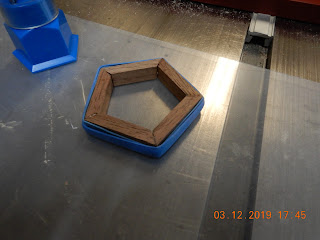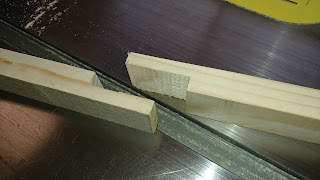For over a few years now I did several micro projects as stands for small household items that ordinarily get shoved into drawers or laid on the kitchen table or desk: pocket knives, small flashlight, pens and pencils, etc. We all know what happens when we need them. It's a lot easier to find them when they're out in the open or when there is a power failure at night, you'd know where that little flashlight is.
A hobbyist woodworker has the advantage of being able to dabble in all kinds of projects - from big to small, from macro projects like a bed or desk to micro ones. I find micro projects a great destination for scrap wood. While I throw away a good amount of scrap, usually soft wood, I hold on to pieces of hard wood or exotic ones, as was the case here.
This project is appropriate because it is a stand or holder of a handful of micro tools, such as the sets of screw drivers and a pair of tweezers with tiny magnifying glass (very handy when I get a splinter) to fix the hinges on eye glasses. Micro tools are a must for replacing small batteries on small gadget controls, even watches, etc.
NOTE: While the reader is not expected to do a project exactly like this one, the techniques and tips here are worth noting.
Micro projects may be small but they require the same precision if not more so sometimes.
 |
| The base holder of this set of micro tools is a pentagon. Cutting miters to 36 deg. at each end of five equal pieces make a pentagon. |
 |
| Tip: Rubber bands are perfect clamping tools for small pieces like this. |
I laminated a light colored hardwood - pink flame - with walnut pieces.
 |
| Tip: Use a spacer along the saw fence to trim off uneven ends. |
 |
| This is where a router table is so valuable. |
 |
| Tip: The only safe way to trim or cut off small pieces is to clamp it on a sliding sled. A long time ago I spent the time to make this jig exactly for the purpose of dealing with small pieces. It comes in handy when you need, so keep it close by. |
 |
| A bench hook, which I covered earlier is simply a good accessory on standby , such as when you need to do some some sanding of small pieces. |
The next two photos below shows how much time I spent to figure out how the screw diver set will "seat" properly on the stand.
If I may say so myself I thought this was a clever idea.
A snapshot of the micro pieces which are obviously not ordinarily located in one place but were made to huddle here for a photo shoot. I'm sure I'll do another one when the need arises.
